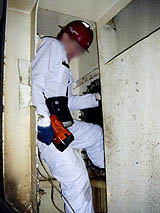Shipyard Employment eTool
General Working Conditions >> Illumination
Adequate lighting is required in walkways, work areas, and general areas of vessels and landside areas to provide a safe work environment (29 CFR 1915.82(a)(1)). Permanent, temporary, and emergency lighting must be provided as required. The components of the lighting must be safe for the location in which it is installed.

Potential Hazards
Inadequate or poor-quality lighting systems can create:
- Slips, trips, and falls
- Electric shocks and burns
- Inability to exit the space
Requirements and Example Solutions

-
Adequate lighting levels in Shipyard Employment must meet the following (29 CFR 1915.82(a)(2), Table F-1):
Table F-1 Lumens
(foot-candles)Area or operation 3...................
5...................
5...................
5...................
10.................
10.................
30.................General areas on vessels and vessel sections such as accessways, exits, gangways, stairs, and walkways.
General landside areas such as corridors, exits, stairs, and walkways.
All assigned work areas on any vessel or vessel section.
Landside tunnels, shafts, vaults, pumping stations, and underground work areas.
Landside work areas such as machine shops, electrical equipment rooms, carpenter shops, lofts, tool rooms, warehouses, and outdoor work areas.
Changing rooms, showers, sewered toilets, and eating, drinking, and break areas.
First aid stations, infirmaries, and offices.Note: The values in Table F-1 do not apply to emergency or portable lights; however, when adequate illumination is not obtained by permanent lighting sources, temporary lighting may be used in conjunction to achieve minimum lumens (29 CFR 1915.82(a)(4)).
-
Temporary lights must be:

- Guarded when bulbs are not completely recessed (29 CFR 1915.82(b)(1));
- Equipped with electric cords designed with sufficient capacity to safely carry the electric load (29 CFR 1915.82(b)(2));
- Equipped with electric cord connections and insulation that are maintained in a safe condition (29 CFR 1915.82(b)(3); and
- Grounded when non-current-carrying metal parts are exposed (29 CFR 1915.82(b)(8)).
- Do not suspended lights and lighting stringers solely by their electric cords, unless designed to do so (29 CFR 1915.82(b)(4)).
- Ensure stringers do not overload branch circuits (29 CFR 1915.82(b)(5)).
- Equip branch circuits with over-current protection that does not exceed the rated current-carrying capacity of the cord used (29 CFR 1915.82(b)(6)).
- The splicing insulation capacity must exceed that of the original insulation of the cord (29 CFR 1915.82(b)(7)).

Portable or Emergency lights are required (29 CFR 1915.82(c)):
- In any dark area that does not have permanent or temporary lights.
- Where lights are not working.
- Where lights are not readily accessible.
- On a vessel or vessel section, where the only means of illumination are not part of the vessel or vessel section.
Risk of Fire or Explosion
- Do not use matches or open-flame devices for lighting purposes (29 CFR 1915.82(a)(5)).
- Only explosion-proof, self-contained temporary and portable lights can be used in any area that the atmosphere is determined to contain a concentration of flammable vapors that are at or above 10 percent of the lower explosive limit (LEL). Such equipment must be approved by a nationally recognized testing laboratory (NRTL). (29 CFR 1915.82(d))

